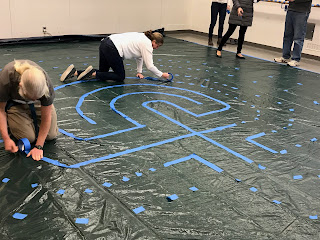As things began to shut down for Covid-19 precautions, and our planned Hornby Island labyrinth workshops needed to be postponed, I got busy cutting up a big Amazon delivery box into 12" X 12" tiles and turning 16 of them into diagonally-striped Roman meander modular components. It was a satisfying way to make some fairly sturdy upcycled manipulatives to play with in designing this kind of labyrinth!
I thought about the idea of making a large playground installation with larger tiles of this sort that could swivel to create new labyrinth patterns. But my neighbour Alex, who saw me experimenting with this idea, pointed out that closely-packed squares don't swivel well (or at all), and the tiles would have to pop up or down to do so.
Reuleaux triangles, on the other hand, do swivel beautifully, but they don't tile the plane. <https://www.youtube.com/watch?v=-eQaF6OmWKw> Hmmm, how to work out a solution to this design problem?
I thought about the idea of making a large playground installation with larger tiles of this sort that could swivel to create new labyrinth patterns. But my neighbour Alex, who saw me experimenting with this idea, pointed out that closely-packed squares don't swivel well (or at all), and the tiles would have to pop up or down to do so.
Reuleaux triangles, on the other hand, do swivel beautifully, but they don't tile the plane. <https://www.youtube.com/watch?v=-eQaF6OmWKw> Hmmm, how to work out a solution to this design problem?



































